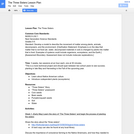
Objectives:
* Learn about Native American culture
* Introduce codependent plants (ecosystems)
- Subject:
- Botany
- Life Science
- Material Type:
- Activity/Lab
- Lesson Plan
- Provider:
- Healthy Planet USA
- Date Added:
- 02/03/2016

Objectives:
* Learn about Native American culture
* Introduce codependent plants (ecosystems)

In this lesson, students investigate photosynthesis through hands-on experiments, videos, and discussion of text. They work in small groups with picture cards to create a chart showing how plants transform carbon dioxide, water, and light energy into carbohydrates and oxygen. After working collaboratively, students will create their own diagrams of photosynthesis. Because plant observations must occur over time, this lesson will take several days to complete. This lesson results from a collaboration between the Alabama State Department of Education and ASTA.

Description: In this activity students become acquainted with the anatomy and biology of seeds. They will use lenses and scales and make drawings to scale. Students will measure and calculate magnifications and they will begin to understand relationships among these. They will organize and summarize their data and, as they do so, they will be developing the understanding and skills needed to undertake more detailed investigations on the biology and reproduction of Fast Plants. Learning Objectives This activity is designed to strengthen students' observational and quantitative skills. In participating in this activity students will: - learn to use magnifying lenses, microscopes and dissecting tools for detailed observation" - measure scales with rulers" - draw to scale, with accuracy and precision to understand scale and magnification" - learn features of the external anatomy of seeds that are associated with certain features of the internal anatomy of seeds" and - estimate the amount of water required to be taken up by seeds in order to initiate germination.

This 5-page article is written by Yizhou Liu and Claudia Solis-Lemus and introduces Wisconsin Fast Stats, a collection of R-developed web apps of data analysis and visualization tools for educators that accompany learning activities from Wisconsin Fast Plants. The article covers topics such as statement of need, descriptions of the website and the app, as well as future work. The WI Fast Stats App is available to view separately.

This resource is a video abstract of a research paper created by Research Square on behalf of its authors. It provides a synopsis that's easy to understand, and can be used to introduce the topics it covers to students, researchers, and the general public. The video's transcript is also provided in full, with a portion provided below for preview:
"Africa contains some of the most species-rich regions in the world. The tropical zone of this continent, for example, harbors the second largest extent of rain forest after the Amazon basin. However, tropical Africa is in the midst of major ecological shifts in response to human pressure and global climate change. Unfortunately, an incomplete understanding of plant diversity in this fragile region may hinder conservation efforts. In an attempt to remedy this, an international team of scientists created the RAINBIO database, a compilation of data gathered from the vast worldwide network of herbaria – or libraries of dried plant specimens. The researchers analyzed over 600,000 specimens for collecting date, geographic occurrence, and growth form (think: trees, herbs, and vines). The results provide an important perspective on plant species richness across the African tropics. For example, Cameroon, Tanzania, and the Democratic Republic of Congo are estimated to be the most species-rich countries..."
The rest of the transcript, along with a link to the research itself, is available on the resource itself.

This resource is a video abstract of a research paper created by Research Square on behalf of its authors. It provides a synopsis that's easy to understand, and can be used to introduce the topics it covers to students, researchers, and the general public. The video's transcript is also provided in full, with a portion provided below for preview:
"Exotic species are a big problem worldwide. While the mechanisms of invasion vary from one exotic species to the next, researchers can tease out patterns that are useful for understanding and ultimately managing invasion. A new study published in the Journal of Biogeography reveals how one team has applied an emerging method known as the phylogenetic field approach to do just that for exotic plants in Japan. The results offer critical insight into how ecology and evolution influence the dynamics of invasion. Darwin’s On the Origin of Species marked the first time biological invasion had been addressed using the principles of evolutionary ecology. But followed to their logical end, these principles yielded two contradictory hypotheses. The pre-adaptation hypothesis states that exotic species successfully colonize assemblages with native species that are ecologically similar because both require the same set of environmental conditions to thrive..."
The rest of the transcript, along with a link to the research itself, is available on the resource itself.

This comprehensive Open Source lesson plan is designed for Kindergarten through Middle School level students to learn about life cycles, plants needs, and plant structures & their functions through hands-on investigations with Wisconsin Fast Plants. Depending on the grade level, students engage at an appropriate depth with developing models and constructing arguments that plants have internal and external structures that function to support survival, growth, behavior, and reproduction. This lesson is available as a Google Doc in the Gather, Reason, Communicate instructional model. You may copy the lesson Doc to your own Drive and edit/adapt for your own use--it is shared by the Fast Plants Program as an Open Education Resource" therefore, you are free to use and adapt for noncommercial purposes, provided you attribute the Wisconsin Fast Plants Programs website (www.fastplants.org) as your source and share openly (for noncommercial purposes) any materials you develop with ours.
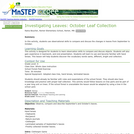
This activity is a field investigation where students collect leaf samples to be observed and compared monthly.

In this biology lab extension, student will have already collected leaves from the playground and surrounding school areas and sorted them into categories according to leaf properties. Students will use the leave classifications/ sorts to graph the properties of the leaves.
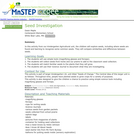
This activity involves seed collection and exploration of common seeds.

This YouTube playlist curated by the Wisconsin Fast Plants Program provides an overview and then demonstrates recommended tending (thinning, managing light intensity, and staking) to help grow healthy, happy plants!
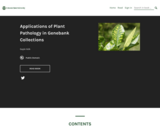
The eBook “Applications of Plant Pathology in Genebank Collections” was developed in part by USDA-ARS and by grant 2020-70003-30930 from the USDA-NIFA-Higher Education Challenge Grant Program. Additional chapters will be added to this eBook when they are available. This eBook contains chapters that can be accessed in any order. Click on “Contents” in the upper left corner and then expand “Main Body” to access chapter titles; scrolling may be necessary to view all chapter titles. Chapters can also be navigated by using arrows at the bottom of each page. Each chapter has text, video and/or interactive content on a single page.
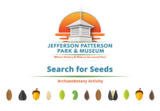
This content includes resources related to the "Search for Seeds - Archaeobotany Activity" available here on OER Commons. In it, Director of the Maryland Archaeological Conservation Laboratory (MAC Lab), Dr. Patricia Samford, presents and demonstrates an activity for students to learn about archaeobotany, or the study of botanical finds in archaeological contexts. Using tweezers and magnifying glasses, students search for seeds mixed in sand or gravel, and use a type collection to identify their finds. What do the finds say about the archaeological environment and uses of plants at a site?

This resource was created by Jessica Wegner, in collaboration with Dawn DeTurk, Hannah Blomstedt, and Julie Albrecht, as part of ESU2's Integrating the Arts project. This project is a four year initiative focused on integrating arts into the core curriculum through teacher education, practice, and coaching.

How can a tree grow in the middle of a field if no one planted it there? In this lesson, students will work to find out the answer to this question by learning how seeds are dispersed. Students will observe different types of seeds and see how they sometimes "hitch a ride" in or on animals to travel great distances. Finally, they will use the engineering design process to make models of animals that help disperse seeds. This lesson results from a collaboration between the Alabama State Department of Education and ASTA.
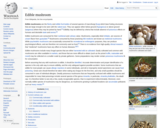
This web page gives detailed information on edible mushrooms under the following headings,
Contents
1. Current culinary use
2.Commercially cultivated
3.Commercially harvested wild edibles
4.Other edible wild species
5.Conditionally-edible species
6. Nutrients
7.Vitamin D
8. Use in traditional medicine
9. Safety concerns
10. Production

This web page describes details of poisonous mushrooms under the headings like,
1.Signs and symptoms
2.Causes
3.Poisonous mushrooms
4.Prognosis and treatment
5.Society and culture
6.Folk traditions
7.Notable cases
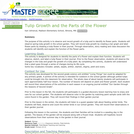
This is a field and classroom activity in which students will observe tulip growth and identify and describe the parts of the tulip flower.

This activity is a guided inquiry where students will find their own lichen and classify it into one of three categories. They will collect, analyze, and present their finding to the class.
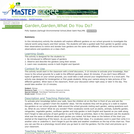
This is a field activity where students explore different types of gardens comparing how they are the same and different.